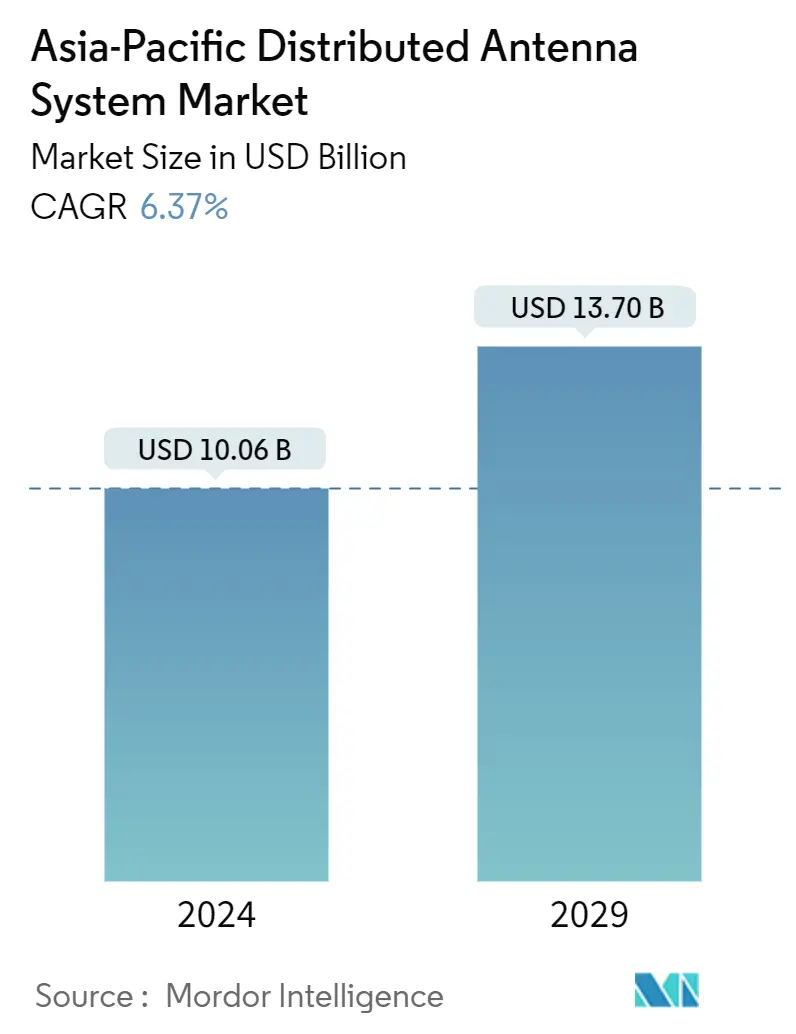Market Size of Asia-Pacific Distributed Antenna System Industry

| Study Period | 2019-2029 |
| Base Year For Estimation | 2023 |
| Market Size (2024) | USD 10.06 Billion |
| Market Size (2029) | USD 13.70 Billion |
| CAGR (2024 - 2029) | 6.37 % |
| Market Concentration | Medium |
Major Players
*Disclaimer: Major Players sorted in no particular order |
APAC Distributed Antenna System Market Analysis
The Asia-Pacific Distributed Antenna System Market size is estimated at USD 10.06 billion in 2024, and is expected to reach USD 13.70 billion by 2029, growing at a CAGR of 6.37% during the forecast period (2024-2029).
The DAS adoption rate has increased dramatically, providing several advantages over single antenna systems. However, this is achieved at a higher cost and by deploying a complicated system. However, DAS is used across various areas to enable businesses to get the coverage necessary for applications.
- Although distributed antenna systems have existed for many years, the increased deployment of wireless networks within buildings with potential applications across smart homes and connected devices has encouraged the implementation of DAS systems increasingly in the market.
- Also, DAS and small cells are one of the core infrastructures upon which the new 5G communication standard is expected to be deployed. DAS can be installed in buildings to boost wireless signals inside them. Often, large facilities, such as stadiums or company premises, are expected to adopt these solutions for the upcoming technology increasingly.
- Due to an increase in residential structures and commercial facilities, a growing number of government programs, an increase in 5G-enabled smartphones, the popularity of Bring Your Device, and more enterprise mobility encourage, the market to grow.
- The cost of a DAS solution varies based on the time and range. For example, passive DAS used to identify the coverage of cellular carriers simultaneously is at the lower end and may cost only a couple of hundreds or thousands of dollars; however, active DAS used for enhancing in-building coverage of one or more mobile service provider networks comes at higher costs.
- The COVID-19 outbreak delayed the 5G deployment in various regions, and the importance of the technology gained traction during the time to cope with the surge in demand for faster connectivity solutions. The deployment and demand for telecommunication infrastructure were expected to boost during the pandemic significantly. Post-pandemic, the market grew rapidly with increased demand for public security connectivity.
APAC Distributed Antenna System Industry Segmentation
A distributed antenna system (DAS) is a network of antennas connected to a common source and distributed throughout a building or an area to improve network performance. The spacing between antennas is such that each antenna gives full coverage without overlapping with other antennas, reducing the number of antennas needed to cover the whole building. This network of antennas is also power efficient compared to a single, larger antenna covering a wide area.
Asia Pacific distributed antenna system market is segmented into type (indoor DAS, outdoor DAS), and country (China, Japan, South Korea, and the rest of Asia Pacific). The market sizes and forecasts are provided in terms of value in USD for all the above segments.
| By Type | |
| Indoor DAS | |
| Outdoor DAS |
| By Country | |
| China | |
| Japan | |
| South Korea | |
| Rest of Asia Pacific |
Asia-Pacific Distributed Antenna System Market Size Summary
The Asia Pacific Distributed Antenna Systems (DAS) market is experiencing significant growth, driven by the increasing adoption of wireless networks and the deployment of 5G technology. DAS offers advantages over traditional single antenna systems, such as enhanced coverage and improved signal strength, making it a preferred choice for large facilities like stadiums and commercial buildings. The market is further propelled by the rise in residential and commercial structures, government initiatives, and the growing popularity of 5G-enabled devices. Despite the higher costs and complexity associated with DAS deployment, its integration into smart homes and connected devices is becoming more prevalent. The COVID-19 pandemic highlighted the importance of robust telecommunication infrastructure, accelerating the demand for DAS solutions to support faster connectivity and public safety networks.
China dominates the Asia Pacific DAS market due to its high smartphone usage and early adoption of 5G services. The market is supported by a growing number of internet subscribers, increased mobile data traffic, and government efforts to enhance telecommunications infrastructure. The region's market is semi-consolidated, with major players like Anixter, Cobham PLC, and CommScope Inc. actively engaging in partnerships and acquisitions to strengthen their market position. Innovations such as Comba Telecom's Green Base Station Antenna and Nokia's 5G low-cost hybrid distributed indoor system are paving the way for technological advancements. The market's growth is also fueled by the increasing acceptance of DAS in healthcare and industrial sectors, as well as the rising demand for indoor distributed antenna systems to meet the connectivity needs of a rapidly expanding digital landscape.
Asia-Pacific Distributed Antenna System Market Size - Table of Contents
-
1. MARKET INSIGHTS
-
1.1 Market Overview
-
1.2 Industry Attractiveness - Porter's Five Forces Analysis
-
1.2.1 Bargaining Power of Suppliers
-
1.2.2 Bargaining Power of Consumers
-
1.2.3 Threat of New Entrants
-
1.2.4 Intensity of Competitive Rivalry
-
1.2.5 Threat of Substitutes
-
-
1.3 Impact of COVID-19 on the Market
-
-
2. MARKET SEGMENTATION
-
2.1 By Type
-
2.1.1 Indoor DAS
-
2.1.2 Outdoor DAS
-
-
2.2 By Country
-
2.2.1 China
-
2.2.2 Japan
-
2.2.3 South Korea
-
2.2.4 Rest of Asia Pacific
-
-
Asia-Pacific Distributed Antenna System Market Size FAQs
How big is the Asia-Pacific Distributed Antenna System Market?
The Asia-Pacific Distributed Antenna System Market size is expected to reach USD 10.06 billion in 2024 and grow at a CAGR of 6.37% to reach USD 13.70 billion by 2029.
What is the current Asia-Pacific Distributed Antenna System Market size?
In 2024, the Asia-Pacific Distributed Antenna System Market size is expected to reach USD 10.06 billion.

